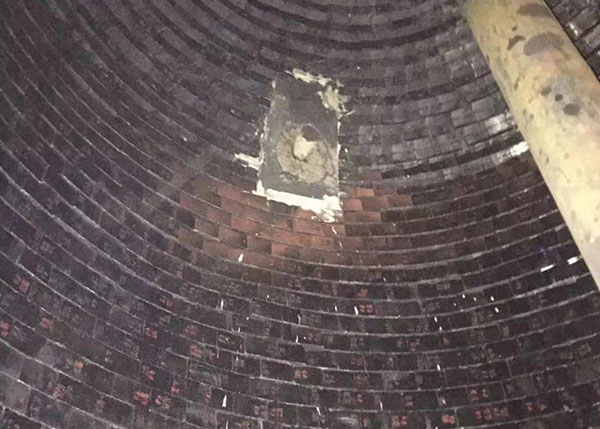Welcome to the official website of Yingkou South Building Dongtai Refractory Company!
Welcome to the official website of Yingkou South Building Dongtai Refractory Company!
Contact:Manager Liu
phone:+86 13840777765
address:China Liaoning Yingkou City Nanlou Dongtai Refractory Co., Ltd.
Website : en.ykdtnh.com
URL:www.ykdtnh.com

Magnesia carbon brick is a high melting point basic oxide magnesium oxide (melting point 2800 ° C) and a high melting point carbon material which is difficult to be infiltrated by slag as a raw material, and various non-oxide additives are added. A non-burning carbon composite refractory material formed by a combination of carbonaceous binders. Magnesia carbon brick is mainly used for the lining of converter, AC arc furnace, DC arc furnace, slag line of ladle and so on.
raw material
The main raw materials for MgO–C bricks include fused magnesia or sintered magnesia, flaky graphite, organic binders and antioxidants.
Magnesia
Magnesia is the main raw material for the production of MgO–C bricks, with fused magnesia and sintered magnesia. Compared with sintered magnesia, fused magnesia has the advantages of coarse magnesia crystal grains and large bulk density, and is the main raw material for the production of magnesia carbon bricks. The production of ordinary magnesia refractories, the main requirements for the magnesia raw materials have high temperature strength and corrosion resistance, so pay attention to the purity of the magnesia and the C/S ratio and B2O3 content in the chemical composition. With the development of the metallurgical industry, the smelting conditions are increasingly demanding. The magnesia used in the MgO–C bricks used in metallurgical equipment (converter, electric furnace, ladle, etc.) requires high density and in addition to chemical composition. Large crystals.
Carbon source
Whether it is in traditional MgO-C bricks or low-carbon MgO-C bricks that are currently in large use, scaly graphite is mainly used as its carbon source. As the main raw material for the production of MgO-C bricks, graphite mainly benefits from its excellent physical properties: 1 non-wetting property to slag. 2 high thermal conductivity. 3 low thermal expansion. In addition, graphite and refractory materials do not co-melt at high temperatures and have high refractoriness. The purity of graphite has a great influence on the performance of MgO-C bricks. Generally, it is necessary to use graphite with a carbon content of more than 95% and greater than 98%.
In addition to graphite, carbon black is also commonly used in the production of magnesia carbon bricks. Carbon black is a highly dispersed black powdery carbonaceous material prepared by thermal decomposition or incomplete combustion of hydrocarbon hydrocarbons. The carbon black particles are fine (less than 1 μm), the specific surface area is large, and the mass fraction of carbon is 90 ~. 99%, high purity, high powder resistivity, high thermal stability, low thermal conductivity, is difficult to graphitize carbon. The addition of carbon black can effectively improve the peeling resistance of MgO-C bricks, increase the amount of residual carbon, and increase the density of bricks.
Binding agent
Common binders for the production of MgO-C bricks include coal tar, coal tar pitch and petroleum pitch, as well as special carbonaceous resins, polyols, pitch-modified phenolic resins, synthetic resins and the like. There are several types of binders currently used:
1) Asphalt materials. Tar pitch is a kind of thermoplastic material. It has the characteristics of high affinity with graphite and magnesia, high residual carbon ratio after carbonization and low cost. It has been used in large quantities in the past; but tar pitch contains carcinogenic aromatic hydrocarbons, especially benzopyrene content. High; due to the strengthening of environmental awareness, the use of tar pitch is now decreasing.
2) Resin materials. The synthetic resin is prepared by reacting phenol and formaldehyde. It can be well mixed with refractory particles at normal temperature, and has high residual carbon ratio after carbonization. It is the main binder for the current production of MgO-C bricks; but it is formed after carbonization. The glassy network structure is not ideal for the thermal shock resistance and oxidation resistance of refractories.
3) A substance obtained by modification on the basis of asphalt and resin. If the binder is carbonized to form a mosaic structure and carbon fiber material is formed in situ, the binder will improve the high temperature properties of the refractory.
Antioxidants
In order to improve the oxidation resistance of MgO-C bricks, a small amount of additives are often added. Common additives are Si, Al, Mg, Al-Si, Al-Mg, Al-Mg-Ca, Si-Mg-Ca, SiC, B4C. , BN and recently reported additives such as Al-BC and Al-SiC-C [5–7]. The principle of action of additives can be roughly divided into two aspects: on the one hand, from the thermodynamic point of view, that at the working temperature, additives or additives react with carbon to form other substances, and their affinity with oxygen is greater than that of carbon and oxygen. , in preference to the carbon being oxidized to protect carbon; on the other hand, from the kinetic point of view, the compound formed by the reaction of the additive with O2, CO or carbon changes the microstructure of the carbon composite refractory, such as Density, blocking pores, hindering the diffusion of oxygen and reaction products.